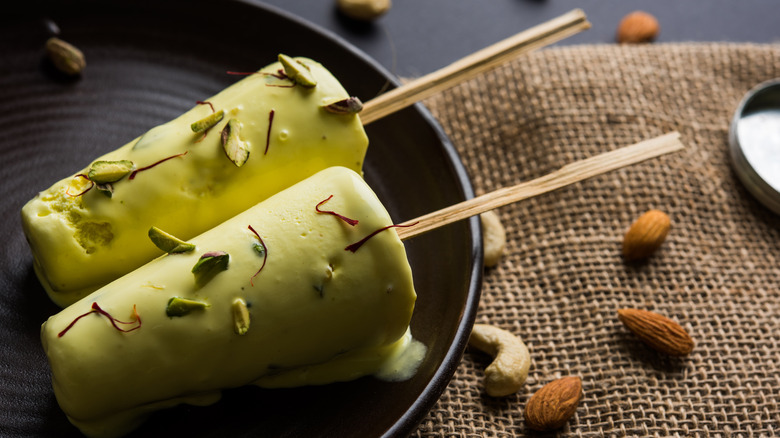The Ancient Country That Invented Ice Cream
Have you ever wondered where that creamy scoop of vanilla ice cream originated? When it comes to deciding what place can lay claim to the king of frozen desserts, it's hard to pin down one straightforward answer. Like other hotly contested culinary origin stories, like the ones for noodles or beer, there have been numerous iterations over thousands of years, many of which have evolved from one thing to another. Many countries have left their indelible fingerprints on the ice cream recipe, but where should one begin?
History would have us look first to the Far East. As early as 200 B.C., Chinese chefs were supposedly making a frozen dairy treat. Back then, they packed a rice-milk mix in fresh snow, pulling it out once it was properly frozen. Though this timeline and recipe can't definitively be proven, consider that the current Mandarin word for ice cream directly translates into "snow cake." Even without this story, the first recorded mention of a frozen dairy treat comes from China's Tang Dynasty (A.D. 618 to 907).
China's early ice cream delight
The earliest form of ice cream wouldn't look anything like the sweet treat we know today. Ancient Chinese records describe the recipe as fermented buffalo, goat, or cow milk that was thickened with a bit of flour. Camphor, a pungent oil made from evergreen trees, was used to flavor the mix before it was placed in metal tubes and frozen in an ice bath or snow. One of the Tang emperors theoretically had over 94 so-called ice men on his staff, many of whom must have been responsible for making this camphor-laced delight. This tradition of frozen dairy made in a cylindrical mold is most similar to India's Kulfi – although that particular delicacy traces its lineage to the Arabic side of ice cream. Speaking of Arabic ice cream, let's follow this dessert to its next destination.
Not too long after the Chinese created their first iteration of ice cream, the Arabs were at work on their own take. Around 800 to 900 A.D., the Arab conquest of the Persian empire led to a similar adaptation to the syrup-laced ice treat sharbat. The Arab conquerors began mixing dairy into the fruit-ice formula. Arabic scientists also introduced another key element to the ice cream-making process: using rock salt and ice to freeze liquids quickly. Still, these iced desserts were still fairly far removed from the modern scoops we know today. For that particular story, we have to head to Italy.
The Far East treat comes to Italy
Though it can't be exactly proven when an early ice cream recipe arrived in Italy — whether through the Arab conquest of Sicily or with the dawn of the Silk Road — dairy-infused ice eventually reached the Mediterranean nation. By the 1600s, communities in Venice, Naples, and Sicily were regularly consuming sorbetto, their take on the Arab fruit-filled ices. Then, in the 1660s, the many pieces of the ice cream puzzle came together. In Naples, Antonio Latini wrote some of the earliest recipes for sorbet as well as a milk-based sorbet. This sorbet, frozen with snow and salt, featured milk, sugar, and candied bits of pumpkin. Most historians claim this is the closest thing to the first recorded recipe for ice cream.
Around the same time that Latini published his recipes, Sicilian chef Francesco Procopio dei Coltelli opened the cafe, Il Procope, in Paris in 1686. The cafe served up a brand new milk ice, known as gelato, to its rather famous clientele, including Victor Hugo and Napoleon. The French were catching on to the ice cream trend too, making their own take that would eventually enchant visiting Americans, like Benjamin Franklin and Thomas Jefferson. From there, ice cream was introduced to the world at large, taking firm root in every country that had the pleasure of tasting it. From China to Persia to Italy, ice cream has taken many sweet forms, each one a step closer to the scoops we enjoy today.



